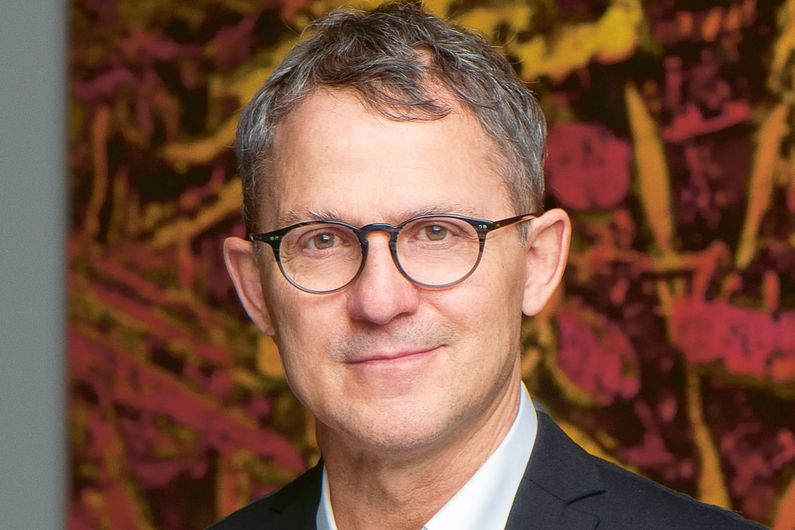Meet Stéphane Aquin, the new director of the Montreal Museum of Fine Arts
- Revue Les diplômés
10/29/2021
- Mathieu-Robert Sauvé
After serving as the MMFA’s curator of contemporary art and chief curator at the prestigious Hirshhorn Museum in Washington, D.C., Stéphane Aquin returns home to head the venerable art institution.
To get to the office – one of the most beautiful in the country, endowed with over 45,000 works of art by such greats as Rembrandt, Picasso, Dali, Renoir and Riopelle – Stéphane Aquin cycles though the Plateau Mont-Royal neighbourhood and downtown Montréal. When he arrives, he locks up his bike and unceremoniously heads inside to start his day as new director of Canada’s oldest museum, the Montreal Museum of Fine Arts.
“I’m very happy to be back in Montréal after six years in Washington, D.C.,” said Aquin, an art historian and UdeM alumnus (B.A. 1985, M.A. 1987). “And I’m not daunted by the challenges ahead because I have such a great team to support me.”
The easy-going 61-year-old was happy to be part of the publicity campaign surrounding his arrival this fall at the helm of the flagship of Québec’s museum network. He knows that all eyes are on him and that he has a “duty to succeed.”
While he is well-respected in the art world, especially after serving as chief curator at the Smithsonian’s Hirshhorn Museum and Sculpture Garden, the United States’ national museum of modern and contemporary art, Aquin has never been a star on the Canadian cultural scene. All that changed with the announcement of his appointment as the MMFA’s new director after a governance crisis at the museum that made the headlines and culminated in the firing of his predecessor. “Someone even recognized me at the pharmacy!” laughed Aquin, a Montréal native whose tenure ends 23 years of French rule at the MMFA (Guy Cogeval from 1998 to 2006 and Nathalie Bondil from 2007 to 2020).
An Aquin but not an Aquinian
The second son of seminal Québec writer Hubert Aquin (1929-1977), Aquin grew up hardly knowing his father. “Today, I am at peace with Hubert Aquin,” he says. “He was a great writer and I have read some of his work, but I am not an expert on him. I am an Aquin but not an ‘Aquinian’,” he added with a smile.
Aquin grew up in California with his mother, Thérèse Larouche, and his older brother Philippe. Money was tight: there was certainly no silver spoon. But his mother managed to send him and his brother to a Catholic boarding school in Switzerland to give them a quality education in French. “Life at the school wasn’t easy. We had no family in Switzerland and the regimentation was dramatically different from life in California,” said Aquin. “It was like going back in time, like we were still in the 19th century – mass three times a week, absolute silence in the dormitory, corporal punishment, forced walks in wet fields in February. But the experience was incredibly formative too!”
The news of Aquin’s appointment was welcomed in the arts and culture world. “His arrival is like a breath of fresh air,” wrote Odile Tremblay in Le Devoir. Jérôme Delgado, Le Devoir’s visual arts critic, noted Aquin’s long involvement in the arts world as an observer and critic. “He likes artists and it shows,” said Delgado, also a UdeM graduate (Arts and Science, 1994). “His experience as a critic and columnist will help him understand the MMFA’s social role.”
Revenge of the drop-out
Ironically, Aquin was anything but a model student and heading a world-class museum like the MMFA (11th in North America, 60th in the world) was never in his career plans. As a teenager, he had his share of escapades that are best left forgotten, and as for the Swiss boarding school, he quit before earning his diploma.
But his time in the cantons of Switzerland did leave him with a deep love of culture and art. “My brother and I were immersed in classical European culture. I studied German and Latin. In French, we had to memorize whole chapters of Corneille and Racine – our teachers thought Cyrano de Bergerac was too easy!”
He returned to Québec in the 80s, where he made a name for himself, first as a literary critic and then as an art critic for the popular weekly Voir. He wrote over 600 columns for Voir from 1992 to 1998, delving into all aspects of artistic creation in Québec, Canada and internationally. He also wrote in English for magazines like Toronto’s Applied Arts and Canadian Art.
After completing a master’s at UdeM under the supervision of Constance Naubert-Riser, Aquin enrolled in a Ph.D. in sociology to explore people’s relationship to art. But after completing his doctoral studies, he felt the pull of the job market and left academia to become curator of contemporary art at the MMFA and then chief curator at the Hirshhorn.
Aquin said he learned a lot from Americans and their propensity for teamwork, which inspired him to create the position of deputy director at the MMFA in order to share governance responsibilities.
“His experience in the U.S. will serve him well,” said Delgado. He also believes that Aquin is well qualified to develop the Museum’s contemporary art collections.
But the new director could also surprise us. “Some of the MMFA’s collections should be showcased more, for example decorative arts,’’ Aquin asserted. “And we have to build closer relationships with artists.”













